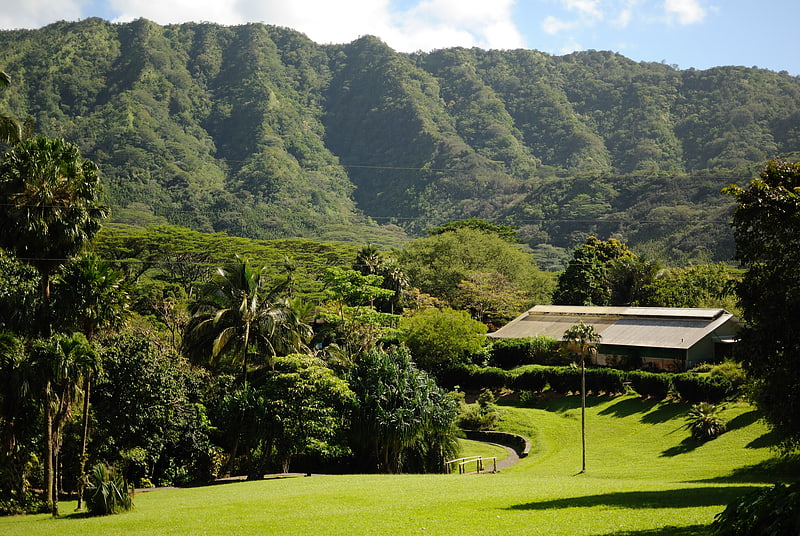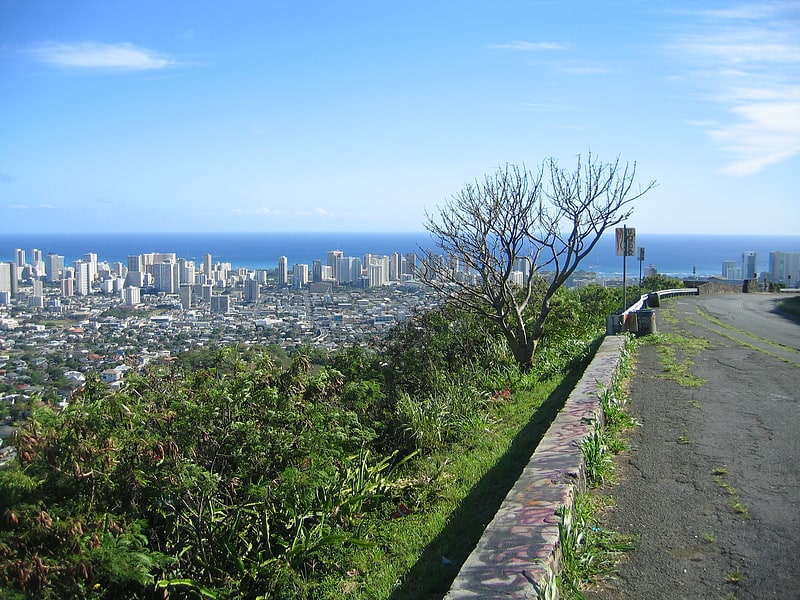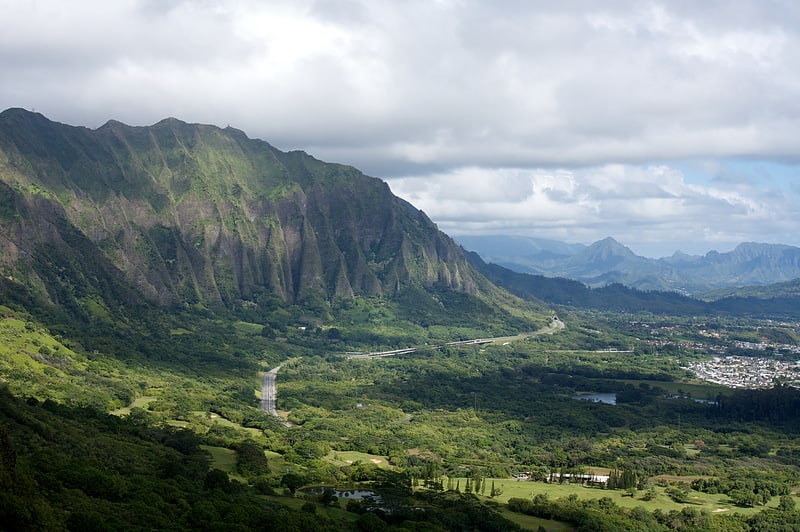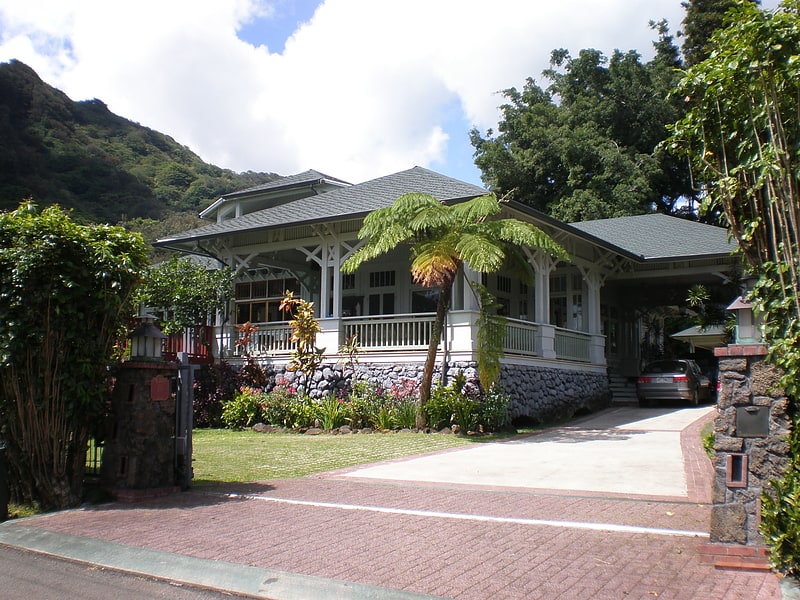Discover 7 hidden attractions, cool sights, and unusual things to do in Hanauma Bay (United States). Don't miss out on these must-see attractions: Lyon Arboretum, Tantalus, and Nuʻuanu Pali. Also, be sure to include Liljestrand House in your itinerary.
Below, you can find the list of the most amazing places you should visit in Hanauma Bay (Hawaii).
Table of Contents
Lyon Arboretum

Arboretum in Honolulu, Hawaii. The Harold L. Lyon Arboretum is a 200-acre arboretum and botanical garden managed by the University of Hawaiʻi at Mānoa located at the upper end of Mānoa Valley in Hawaiʻi.
Much of the Arboretum's botanical collection consists of an artificial lowland tropical rainforest with numerous trails and small water features.[1]
Address: 3860 Manoa Rd, Hanauma Bay
Tantalus

Cinder cone in Hawaii. Mount Tantalus is an extinct cinder cone in the southern Koʻolau Range on the Hawaiian Island of Oʻahu. It also has a summit crater, Tantalus Crater. The cinder cone formed after the demise of Koʻolau Volcano, during a time of rejuvenated-stage volcanism in southeastern Oʻahu that also formed Punchbowl Crater, Diamond Head and Koko Head as part of the Honolulu Volcanics. Tantalus overlooks the modern city of Honolulu, which is built on top of Tantalus cinders.[2]
Nuʻuanu Pali

Nuʻuanu Pali is a section of the windward cliff of the Koʻolau mountain located at the head of Nuʻuanu Valley on the island of Oʻahu. It has a panoramic view of the windward coast of Oʻahu. The Pali Highway connecting Kailua/Kāneʻohe with downtown Honolulu runs through the Nuʻuanu Pali Tunnels bored into the cliffside.
The area is also the location of the Nuʻuanu Freshwater Fish Refuge and the Nuʻuanu Reservoir in the jurisdiction of the Hawaiʻi Department of Land and Natural Resources.
The Nuʻuanu Pali State Wayside is a lookout above the tunnels where there is a panoramic view of Oʻahu's windward side with views of Kāneʻohe, Kāneʻohe Bay, and Kailua. It is also well known for strong trade winds that blow through the pass (now bypassed by the Nuʻuanu Pali Tunnels). The Nuʻuanu Pali Tunnels were built in 1958. Before this road opened, people would use what is now known as the Old Pali Road, currently a popular hiking route.[3]
Liljestrand House

Historical place in Honolulu, Hawaii. The Liljestrand House at 3300 Tantalus Drive in Honolulu, Hawaii, was designed by Vladimir Ossipoff for Betty and Howard Liljestrand, a doctor and nurse who had bought the hillside site overlooking downtown Oahu in 1948. Completed in 1952, the house "was perhaps Ossipoff's most intricate as well as his most widely publicized domestic commission." After it was featured in House Beautiful magazine as a Pace Setter House in 1958, it attracted hundreds of visitors in organized weekly tours. It was listed on the National Register of Historic Places in 2008.[4]
Address: 3300 Tantalus Drive, Hanauma Bay
Dr. Archibald Neil Sinclair House

Building in Honolulu, Hawaii. The Dr. Archibald Neil Sinclair House on Puʻu Pueo overlooking Mānoa Valley and Diamond Head on the island of Oʻahu was built in 1917 in a Colonial Revival style designed by a leading local architectural firms, Emory and Webb, who also designed the Hawaii Theatre and other fine buildings on the island. The large, sloping property has two entrances: one below the front lawn at 2726 Hillside Ave. the other above the house at 2725 Terrace Dr. Honolulu, Hawaiʻi. It was listed in the National Register of Historic Places in 1983.
The two-story, wood frame, 2,811 sq. ft. main house is a fine example of the Colonial Revival style as adapted to Hawaiʻi, with extensive verandahs and balconies outside and open spaces inside delineated by columns rather than walls. Its foundation rests on lava rock and redwood piles. There is a separate, 240 sq. ft. maid's quarters and garage accessible from Terrace Drive and an underground bomb shelter (added later) below the front lawn.
Dr. Sinclair (b. 20 January 1871) was a prominent physician whose father had come to Honolulu from New York to supervise the construction of ʻIolani Palace. He attended Punahou School then obtained a medical degree from the University of Glasgow in Scotland in 1894. He began his medical practice in England before returning to Honolulu, where he served with the United States Public Health Service (1900–1919), as city physician (1901–1909), and as founding director of Leahi Home for tuberculosis patients (1901). His published research in the fields of bacteriology, immunology, and pulmonary diseases earned him induction into the American College of Physicians and other medical societies. The Sinclair Society of pulmonary specialists is named for him.
The house was built in the College Hills tract (named for Oahu College, now Punahou School), a rapidly expanding suburb of Honolulu that was newly served by the extension of electric streetcar lines into Mānoa in 1901 and the relocation of the College of Hawaii to Mānoa in 1912. Many later residents of the house have been students and faculty of the University, the most notable being Janet Bell, who served as curator of the Hawaiian Collection from 1936 until 1970.[5]
Edgar and Lucy Henriques House

The Edgar and Lucy Henriques House at 20 Old Pali Place in Honolulu, Hawaiʻi was built in 1904 for the Henriques couple, who had married in 1898.
Edgar Henriques was a businessman who had arrived in Hawaiʻi from New York City in 1896. Lucy was of high-born Hawaiian aliʻi heritage, descended from Isaac Davis, a British seaman who served as advisor to Kamehameha I in dealing with foreigners and in conquering the other islands. Lucy's aunt, Lucy Kaopaulu Peabody, built the house for the couple and also lived there herself until her death in 1928. It stands as one of the best-preserved and few surviving examples of a grand "kamaaina" dwelling from the end of the 19th century, with a covered porte-cochere and wraparound lānai; a splendid, wide-open interior; and large doors and windows that could easily be opened to tropical breezes. Its architect was Thomas Gill, father of Thomas P. Gill, and it was listed on the Hawaiʻi and National Register of Historic Places in 1984.
Lucy Kalanikumaikiekie Henriques was active in the Daughters of Hawaii, the Hawaiian Historical Society (HHS), and the Kaahumanu Society. Her husband Edgar was a prominent member of the business community and also active in the HHS, publishing occasional studies on traditional Hawaiian history and culture. Edgar and Lucy had a large collection of Hawaiian cultural artifacts, which are now in the Bernice P. Bishop Museum.
In 1932, Lucy Henriques willed land and a trust fund to establish a medical facility at Mahahikilua in Kamuela, Hawaii. After many delays, the Lucy Henriques Medical Center finally opened in 1977, eventually merging with North Hawaii Community Hospital in 1999.[6]
James L. Coke House

Building in Honolulu. The James L. Coke House, also called Waipuna, at 3649 Nuʻuanu Pali Drive in Honolulu, Hawaiʻi was built in 1934 for Judge James L. Coke, who had that year been reappointed Chief Justice of the Hawaii Supreme Court by U.S. President Franklin D. Roosevelt. Its architecture is significant as an example of the residential work of C.W. Dickey, the most prominent local architect of the period, and its landscaping represents the work of the preeminent landscape architect of the period, Richard Tongg. The house and grounds were added to the National Register of Historic Places in 1986.
The house is not typical of Dickey's residential work, but displays fine craftsmanship and is well adapted to an indoor-outdoor lifestyle. It is a two-story, double-wall building on an L-shaped plan, with a gabled roof over one wing and a hipped roof over the other. The outside walls are of brick on the ground floor, with clapboard siding on the upper floor, both painted white. The interior floors are of ohia wood and the stairway bannister and dining room chandelier are of wrought iron.
Tongg landscaped both the front yard and the back lot, which straddles Nuʻuanu Stream, during 1935–37. Among his other notable landscape designs were Andrews Outdoor Theatre at the University of Hawaiʻi, the Alexander & Baldwin Building, local residences for George W. Vanderbilt and Doris Duke, and the central concourse garden at Honolulu International Airport.[7]